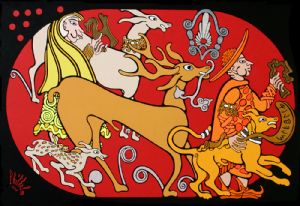| |

|

|
E73 - RURAL WALK IN ETRURIA - 2007
Painting Acrylic
Size: 49,2 x 74,8 inches
15300 USD
Description:
ETRUSCAN / Acrylic on canvas 125 x 190 cm - 49,2 x 74,8 inches / (Text translated by Google) / As the chart E71 - Aulos player, the charter pictorial series Etruscan remains the same: the characters always come to an oval or oval, for a symbolic passing of the past in our present? Inspired by Greek obvious. The reasons for this table are largely a bronze situla rejected the grave Capodaglio 38. What do we see? The image of a quiet couple of walkers Etruscan, accompanied by a family of deer and a dog. A stylized lotus blossom in the jaw of the deer and decorative palm leaves in the sky. The man who could be a priest, holding in one hand a cross-shaped emblem, borrowed from the goddess of animals Potnia Theron, in the other hand, a cartridge with Etruscan inscription: Philhelm. If the woman's face has been revised and corrected from the original, the man's scrupulously respects the characteristic figures of the era. The woman holds the Philhelm monogram, or a triple signing converted three times in this table.
Etruscan: In Latin Tuscii, people who lived in Etruria, the present-day Tuscany and northern Lazio, is the center of the Italian peninsula. Their culture was born in the first millennium BC, with a peak between the seventh and fifth century BC Their language, undeciphered to date, however, is a slightly different Greek alphabet, which gave birth to the Latin alphabet! Their origin is East, indeed the resemblance between some Etruscan tombs and other Asia Minor, and certain aspects of their culture seems much more oriental qu'italiques, as the pleasure of luxury, love for parties and dances, and their practice of hepatoscopy or analysis of liver victims to make predictions.
Situla: situla the vase was truncated with the narrowed-down, sharp edge to the shoulder or slightly rounded, broad, short neck, the flat lid barely rounded or pointed at the center. Large situlae of all materials were part of the equipment of the temples. Small in size, equipped with a handle, the situlae calcite, earthenware or metal used to carry water from spraying ritual. Its use in growing fields of urns.
Potnia Theron : Mistress of Animals = Title ancient Goddess Minoan Crete in the Aegean Sea between 2700-1450 BC. Also represented in Asia Minor and Greece where it was called Artemis, still represented surrounded by and other animals, often rampant.
|
|

|
|